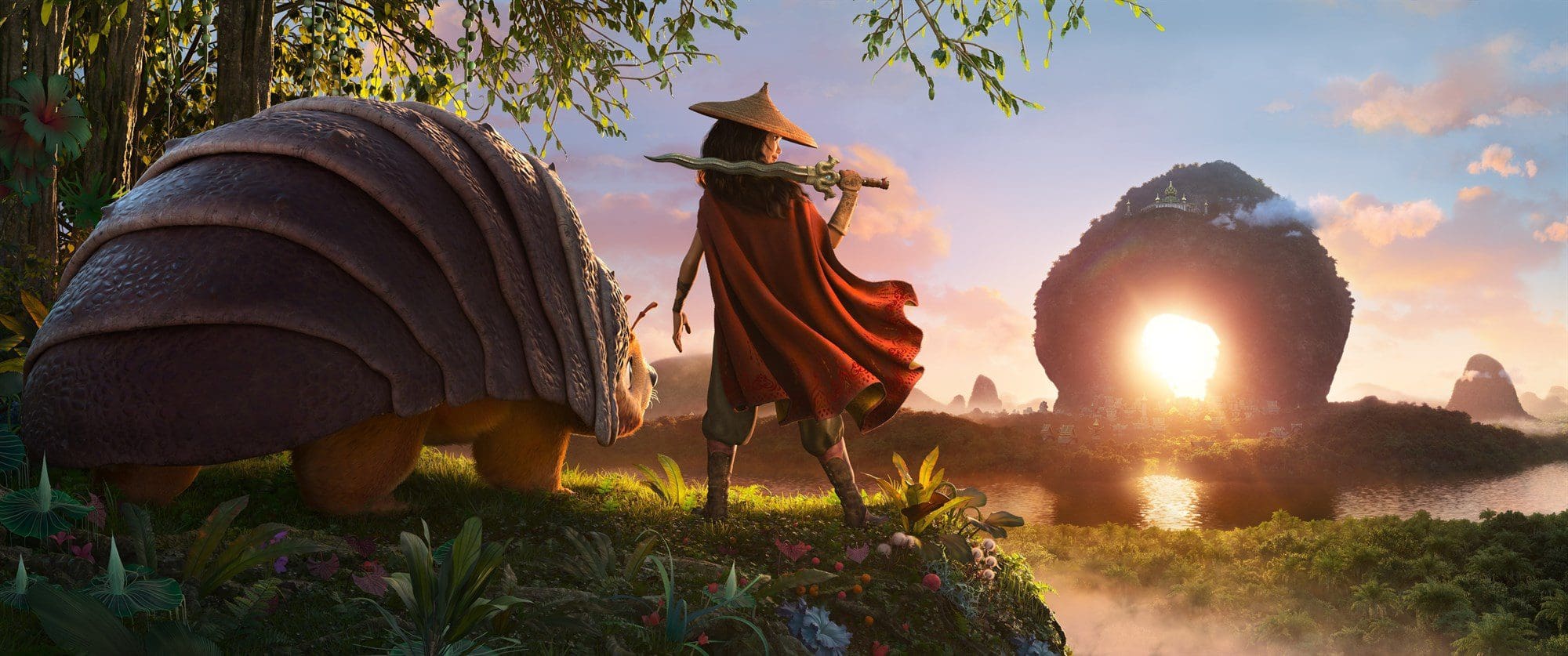
Raya and the Last Dragon is Disney’s first big cinematic outing of 2021 and arguably the first big film of the year. It boasts a big world, big action sequences, and big thematic ideas that are ambitious, but don’t always quite come together.
It takes viewers into Southeast Asia, back when dragons roamed and fought against a devastating, dark force known as the Druun to protect the people of Kumandra. Kumandra is easily one of Disney’s most visually detailed worlds, as all the villages that make up the divided region have a strong visual identity. For instance, Spine is shrouded in a thick, wintry fog that gives an advantage to the group of strong warriors that reside there. Talon is designed more like a crowded marketplace—the perfect location for clever pickpockets and thieves.
The most important village within the region is Heart, though, as it contains the powerful orb created by the dragons as a sacrificial last act to ward off the Druun and protect the people of Kumandra. However, after all five tribes converge and fight over the orb to help their village, it cracks into pieces and the Druun return to encase all the people in stone. Now, being the last of the Heart tribe years later, a warrior princess named Raya (voiced by Kelly Marie Tran) seeks out Sisu (voiced by Awkwafina), the last surviving dragon, to recollect all the pieces and cast out the Druun.
Raya is easily one of the stronger, more compelling Disney protagonists in recent times, with the way the film establishes her upbringing and the betrayal that drives her journey. The opening is really great in delving into some of the lore surrounding Kumandra, showcasing Raya’s fighting and tactical prowess with the help of her trusty armadillo/pill bug steed Tuk-Tuk (voiced by Alan Tudyk), and establishing the event that keeps everyone divided. After she’s on her own, Raya becomes an outcast and the final hope that you really end up rooting for as she’s relatable in that she isn’t this perfect force for good. Although her father’s desire to unify the tribes is what drives her, she’s still going through her own issues of betrayal with Fang princess Namaari (voiced by Gemma Chan) and has some grudges in her own heart that make her unable to fully forgive her.
This is what makes Raya and Namaari’s arcs so strong, as they wrestle with their own feelings about where things have gone, and how their perspectives have perpetuated this divide. While their incredibly action-packed fights are thrilling to watch, it’s seeing them come together through powerful moments of forgiveness that really sticks with you. Both Tran and Chan put in great vocal work that adds to the emotions and personalities of their characters and fits incredibly well with the setting and time period while also adding in some modern dialect.
The same, unfortunately, can’t be said for Awkwafina as Sisu, since her voice is so distinct and distracting that it sticks out. Sisu acts as a good mentor for Raya. She is reminder of Raya’s father’s wish for everyone to no longer live divided and she serves as a force for Raya’s change of heart in a pivotal moment. Awkwafina does a great job getting this message across and leaves an impact, but her voice just doesn’t fit like everyone else’s and she tries too hard to be comical too much of the time.
The film’s theme of unity doesn’t always fit or feel fully fleshed out. For younger audiences, Raya and the Last Dragon works well in opening their eyes, minds, and hearts to accepting and compromising with others. It showcases the devastation and persistence of grudges and greed through finger-pointing and presents the idea that it’s more important to work towards something better by coming together. It’s a message that’s great for a younger generation growing up in such politically charged times. As for adults and even a more socially aware teen generation, however, the film’s messages about unity feel thin and aren’t fully reflective of the issues that currently divide us.
The film’s whole idea of everyone having the same desire of “wanting a better world’’ might have been fine a decade or two ago, but a lot has changed and if you think that everyone has the same definition of a “better world” anymore, that simply isn’t true. It’s honestly sad that as admirably optimistic as this film’s idea of unity is, it’s also incredibly easy to pick apart because of how basic it is.
Outside of us knowing that Fang suffers from a lack of food resources, the film doesn’t go in depth at all when it comes to the three other tribes. We don’t really understand what their issues are or why they even need the orb aside from not wanting Heart to have it. If there were more time spent getting to know the other tribes and fleshing out their own prejudices or issues, the film’s unifying moments would have been more reflective of our own issues and would have left a deeper impact. Instead, the ending moment of everyone coming together feels phony and forced, making the film’s messaging feel unrealistic and even a little tone-deaf.
There’s a lot to like about Raya and the Last Dragon, with its great characters, world, and the strong performances and animation that deliver its well-intentioned messages. However, its shortcomings keep it from being the great force for change it wants to be.

